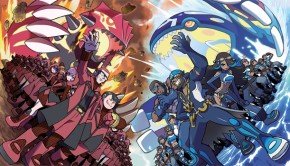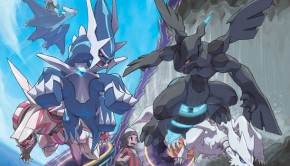Moves Like Swagger
While not completely unused before, one of the biggest differences between what was seen at the United States and Canadian National Championships compared to what was seen in the Spring Regionals was the rise of a single move: Swagger. With two Swagger users on the winner of the Japanese Nationals Masters division’s team, it is likely players looking to have similar success will imitate the strategy. Swagger’s prevalence in Japan expands beyond the winning Masters team: in the Japan Cup, the Wi-Fi tournament that Japanese players competed in to earn an invitation to their Nationals, Swagger was the single most used move on the Cresselia of top performers, coming it at a 54.9% usage rate. Thundurus, too, frequently carried Swagger in this event: while it was only the 4th most common move for Thundurus, 45.1% of top performers used it on him. Despite being a strange fit for the normally highly offensive metagame of the English-speaking Pokemon community, Swagger has begun showing up more frequently on Pokemon Online recently as well as on American Wi-Fi teams and made some token appearances in the United States and Canadian National Tournaments.
A quick recap on what Swagger does if anyone has been fortunate enough to forget:
- Swagger raises the target’s attack by 2 levels, but also confuses them
- Swagger has 90% Accuracy
- Confusion lasts between 2-5 turns with the target having a 50% chance to hit themselves in confusion each turn.
- Confusion damage scales on the targets Attack and Defense, so Swaggering a target multiple times to raise its Attack is sometimes beneficial even if it is still confused.
Using Swagger
The most obvious use of Swagger is the way it was intended to be used when it was introduced: a way to confuse your opponent, hopefully causing some extra self-damage because of the attack boost involved. It’s still plenty useful for that, giving you a 45% chance to disable your opponent after factoring in Swagger’s 90% accuracy. It’s worth noting up front that you need to be careful with what Pokemon you’re giving +2 Attack to. It almost goes without saying, but unless you’re desperate, you don’t want to risk giving that Garchomp or Metagross two levels of attack with Swagger in hopes of them hurting themselves in their confusion. Even if they’re only able to attack every other turn while they’re confused, they’re still going to average the same damage per turn as if you hadn’t Swaggered them at all.
While Swagger is a decently reliable way to disable a Pokemon, targeting your opponents is only one part of why Swagger is so powerful. Using the mechanics of double battles to your advantage, Swagger can be used in conjunction with the move Safeguard, the ability Own Tempo, or a Persim or Lum Berry to give the Swagger user’s partner an effective Swords Dance without the confusion drawback while still freeing up the partner to move (or to receive the Swagger on the switch in). Due to the set up required, executing this strategy is usually most effective with bulky Pokemon so that they can take advantage of the stat boost and/or the potential debilitating effects of confusion over several turns. While Swagger is available to a majority of fully evolved Pokemon due to being a well distributed TM move, some Pokemon stand out as potentially effective users of the move. The best examples of effective Swagger users are probably the aforementioned Thundurus and Cresselia, though each of them have unique strengths using the move.
An example of an effective Swagger Thundurus is shown below, recently seen crushing the dreams of his enemies for the Japanese Nationals Masters winner:
![]()
Thundurus (M) @ Sitrus Berry
Ability: Prankster
EVs: 252 HP / 132 Def / 4 SAtk / 116 SDef / 4 Spd
Calm Nature (+SDef, -Atk)
– Swagger
– Taunt
– Thunder Wave
– Thunderbolt
Thundurus has been a menace in VGC ever since he was released due to his ability, Prankster, which adds +1 priority to each of his non-damaging moves. Not content with being the token jerk of the 2011 World Finals, Thundurus is back with a new priority probability move to be even more frustrating to play against, as Swagger joins Thunder Wave potentially stopping his opponents’ attack from going off. Priority Swagger is difficult for the opponent to deal with due to the relative lack of counterplay available. Barring some bizarre circumstances with niche abilities and moves, unless the target is holding a Lum or Persim Berry Thundurus has a 45% chance to stop an opponent from moving due to Prankster’s priority boost and there’s little the opponent can do about it but pull the handle on the slot machine and hope for 7s. This particular Thundurus makes the gambling even more fun by carrying priority Thunder Wave as well, allowing for priority Parafusion and the option of lowering the opponent’s speed for his sweepers.
Using Swagger exclusively as a disruption tool is a really limited way to use a powerful move. Fortunately for Thundurus, his ability makes him among the best offensive users of Swagger by boosting his teammate’s attack as well as defensively disrupting his opponents. Prankster allows Thundurus to have an advantage over most other potential Swagger users when targeting his teammates. Because of the priority boost, he’s able to move before his teammate in almost any situation and fire off Swagger in time for the teammate to use the attack boost on the same turn rather than “wasting” a turn of the boost by using it after his teammate has already moved.
An important example of why this is important is seen with a teammate like Conkeldurr. Conkeldurr’s Mach Punch is ordinarily a 2HKO on flimsy Excadrills. However, that 2HKO becomes an OHKO if Conkeldurr has already received the attack boost from Swagger. While most Swagger users would go after Excadrill and make this tactic ineffective due to Mach Punch’s +1 priority, Thundurus’ naturally high Speed and the effect of Prankster allow it to move before Conkeldurr and give it that attack boost in time for it to kill the helpless Excadrill before it can attack. There are a couple other potential users of Swagger who can exploit Prankster and mix in their own bag of tricks, such as Whimsicott with Tailwind and Encore and Sableye with Will-O-Wisp and Trick.
It’s also noteworthy that this Thundurus is not running anything close to a 252 Speed/252 Special Attack EV spread. If you are using a Pokemon primarily to boost the effect of your other Pokemon, it tends to be much more useful to build them more defensively so they can hang around and apply their tools more often rather than building them offensively to hit harder or sooner when they have a window to attack. Even in the case of a potentially strong attacker like Thundurus, it’s important to EV a Pokemon to perform their job well; this Thundurus, for example, is using his Thunderbolt to finish off weakened enemies, not to lead your team’s offense.
Where Thundurus is effective with Swagger mostly due to his speed, other Pokemon, such as Cresselia, make excellent use of the move through their bulk. To give a familiar example, here is the Cresselia from the same team as the Thundurus:
![]()
Cresselia (F) @ Leftovers
Trait: Levitate
EVs: 220 HP / 4 Def / 156 SAtk / 36 SDef / 92 Spd
Bold Nature (+Def, -Atk)
– Ice Beam
– Psychic
– Swagger
– Thunder Wave
Cresselia’s set is pretty straightforward: it uses its immense bulk to provide Swagger and Thunder Wave support, disrupting enemies and slowing down opponents to protect her sweepers, then boosting her sweepers offensive power so the sweeper can clean up.
The subtle part of this Cresselia’s spread is her speed: the 92 Speed EVs brings it up to 117 Speed, which is exactly 1 more speed than one of her teammates, a 204 Speed EV Adamant Metagross holding Lum Berry, who clocks in at 116. These speeds exemplify a similar concept to the Thundurus/Conkeldurr example above: one of the most important parts of designing a team to use Swagger to support your own Pokemon is to set yourself up so that the Swagger will go off first in ordinary situations while still letting both your Pokemon hit speeds that will allow them to beat the opponents you want to beat. This is where Pokemon like Cresselia with its massive base stat total really shine: with relatively little speed investment she’s able to stay ahead of some of the slower sweepers, stay bulky, and even have some room for offensive investment to help clear the way for targets her sweepers struggle with. Cresselia ordinarily wouldn’t be running so much speed, but she’s sped up to play nice with Metagross and be able to Swagger and attack on the same turn without running a slower Metagross than desired.
Like Thundurus, in addition to Swagger Cresselia carries Thunder Wave to slow down opponents for her sweepers alongside Swagger. It isn’t always necessary to be carrying both moves, but in addition to powering up their teammates’ attacks it is important to remember that it is the job of these Pokemon to set up a situation where the sweepers are able to sweep, not to haphazardly confuse and boost targets. If you are using slower, bulkier sweepers, it is important to slow down the opposition before sending out your sweeper so that the sweeper can pick up kills without taking unnecessary damage.
The same speed logic with the Metagross and Cresselia speeds works for Trick Room teams too, but the numbers need to be reversed. Rather than trying to have your Swagger user be at least a point faster than your sweepers, you should aim for them to be a point slower so that Swagger goes first under Trick Room. All of the viable Trick Room users have Swagger available to help out if you’d like to use it as a part of your strategy, though it tends to be more effective to use it on bulky Pokemon. Examples of safer options include Slowking, Cofagarius, and Jellicent, with notable riskier options being Reuniclus, Chandelure, and Gallade. Keep in mind that EVs aren’t the only way to adjust speed: using a speed IV in the teens instead of 0 or 31 might help you get your Pokemon moving in the correct order. There are a significant number of Japanese players who go as far as to give Cresselia the otherwise useless item Macho Brace to get her slower than their Swagger recipients for this strategy.
Swagger Targets
So we’ve established some of the strongest Swagger users in the metagame, but who do we power up? Generally, the best options are bulky sweepers who are difficult to force out or OHKO so that the Swagger boost and Berry aren’t wasted. Depending on how hard you want to commit to the strategy you can have one or two planned recipients on your team via Lum and Persim Berry (technically you could have more with abilities like Own Tempo if you wanted to completely be a one trick pony, but that sucks, so don’t do that). Obviously, Lum Berry is the stronger item of the two, and should be selected in most cases where you only plan to hit one Pokemon with Swagger, since it is a strong item even if you never use Swagger. Many Japanese players seem to favor using Metagross and Scizor as their Swagger targets, which makes sense since fitting a Steel Pokemon on your team to absorb Dragon type attacks is pretty important. One of the cheekier spreads I’ve seen used for this is the following:
![]()
Scizor (M) @ Lum Berry
Ability: Swarm
EVs: 236 HP / 252 Atk / 20 SDef
IVs: 0 Speed
Brave Nature (+Atk, -Spd)
– Bullet Punch
– Acrobatics
– Protect
– Bug Bite
Designed for use on a Trick Room team, this Scizor has some interesting tricks, though it is committing very hard to being able to execute a Swagger setup. While Acrobatics is most commonly seen with Flight Gem (especially on Pokemon Online thanks to its bugged damage), there are other ways to lose your item. By Swaggering Scizor before it attacks, it gets both the +2 Attack as well as the boost to Acrobatics damage from not holding an item, allowing it to do some crazy things like OHKO its usual counter, Volcarona. Even in situations where Acrobatics is not going to be Scizor’s primary form of offense, 400 Attack after a Swagger would be enough for Scizor to defeat even some level 100 Pokemon, making the comparatively flimsy Pokemon he sees at level 50 in VGC easy prey.
Lum Berry tends to be used rather than Persim on the above set because it offers more utility. I think including a slot for a Persim user on your team is ordinarily a poor choice because of the frequency of battles where it will do nothing at all due to its lack of flexibility. With something like Lum Berry Scizor or Metagross, at least you can use the Lum Berry to block Spore or avoid untimely burns and freezes if you don’t use Swagger on them. In both cases, Lum might have been the best item on them even if you didn’t have Swagger at all, with the availability of Swagger simply enhancing the utility of the Lum Berry when appropriate. Persim Berry lacks these benefits: unless your opponent is also using Swagger and ballsy enough to gamble with hitting a physical sweeper with it, you’re essentially playing without an item if you don’t get to use Swagger, handcuffing your play, as well as your Pokemon choices in team preview. While most teams probably won’t want a Persim user, the use of Persim Conkeldurr is witty enough to warrant one final look at the Japanese Masters Champion’s team:
![]()
Conkeldurr (F) @ Persim Berry
Ability: Guts
EVs: 252 HP / 12 Atk / 244 SDef
Adamant Nature (+Atk, -SAtk)
– Detect
– Drain Punch
– Mach Punch
– Rock Slide
Conkeldurr technically doesn’t get around most of the problems I mentioned previously, but I really enjoy the cleverness of putting Persim Berry on a Pokemon with Guts. If you’d used Lum Berry instead, you’d sometimes be worse off: Conkeldurr usually doesn’t mind getting Paralyzed and almost always likes getting Burned and Poisoned, and with Persim Berry, you’re still able to get Guts boost from those statuses while being Swaggerable. Persim synergizes pretty nicely with Guts by allowing the possibility of both types of boosts during the battle, though obviously it loses the near immunity to Spore it would have had if it was using Flame Orb or Toxic Orb like Guts users ordinarily do.
There are some other factors that make Conkeldurr a particularly good Swagger recipient. Like Scizor’s Bullet Punch, it has a priority move in Mach Punch that allows it to threaten weakened, faster foes. The combination of a priority move and the healing from Drain Punch make it difficult to force out if it doesn’t allow the enemy to deal free damage to it, healing up with +2 Drain Punches when it is forced to take damage and avoiding potential damage by Mach Punching weakened enemies before they are able to damage it. Other Guts Pokemon can be similarly effective with Persim if their attributes would be more useful to your team than Conkeldurr’s.
Countering Swagger
So let’s say your team is mostly set or you just aren’t interested in the strategy, but you want to know what you can do to stop it. Sadly, part of why Swagger is such a popular move in the more developed Japanese metagame is because there aren’t a lot of excellent counterplay options available, but here are the best ways to deal with it.
Taunt: Taunt is the single best way to deal with Swagger and most of its accompanying strategies. Swagger users who are dedicated to being defensive support Pokemon are normally crippled by Taunt due to their comparably weak offense. Taunt is the most effective counter to teams relying on Swagger because unlike essentially every other option, it stops both offensive and defensive uses of Swagger by preventing the move completely. Disable offers a weaker version of the same effect. Ironically, the best users of Taunt are all capable Swagger users as well, such as Prankster Thundurus, Sableye, and Whimsicott. Any reasonably quick Taunt user that isn’t weak to Psychic or preferably Ice will turn the tables on Cresselia and leave it frustrated, likely forcing a switch.
Rage Powder/Follow Me: While there’s a big drawback to pulling Swagger to your Ragepowder/Follow Me user in that it is going to be confused instead, this is the only option other than Taunt that reliably disrupts both types of Swagger use by pulling Swagger away from its intended target(unless, of course, the Follow Me/Ragepowder user was the intended target, which isn’t that unlikely given that they’re all special attackers, in which case you just wasted a turn…
Lum Berry: I am generally of the opinion that Lum Berry and Sitrus Berry belong on every team and this sort of strategy is one of the best reasons why you need the former. Sometimes your opponents will try to use disruptive strategies involving status effects. Don’t leave yourself defenseless. Persim Berry also works, but is specific to the point of not being very reasonable as a counter.
Safeguard: I think Safeguard is probably the single most underrated move in the game right now. It shuts down attempts at offensive Swaggers and Thunder Waves, as well as messing up some strategies from other Pokemon such as Amoonguss’ Spore. Safeguard is an option that doesn’t necessarily require a dedicated Pokemon if you have a spare move slot, as many strong Pokemon like Ninetales, Dragonite, Togekiss, Cresselia, Arcanine, Scizor, Slowking, Gallade, Regice, Latios, Latias, Abomasnow, Whimsicott, Jellicent, Chandelure, Terakion, and Virizion can learn Safeguard and use it with varying degrees of success.
Unnerve: A strange solution to people using Swagger offensively, if you can get an Unnerve Pokemon out while Swagger is used you’ll get through the enemy Lum/Persim Berry and cause the recipient to actually become confused. It’s sort of difficult to use in this case because most of the better Unnerve Pokemon, most notably Tyranitar, Houndoom, and Aerodactyl, really don’t want to try to fight common Swagger recipients like Metagross, Scizor, and Conkeldurr due to their typing. Still, it gives you that 45% chance of causing the opponent to disrupt their own team, which is hilarious at the very least. Bug Bite offers a similar solution that doesn’t require you to keep a Pokemon in to maintain the effect but that is more difficult to set up.
Encore: While forcing the opponent to Swagger you is resigning to gambling in many cases, limiting your opponents options limits the impact they can have and make them predictable. Predictability is something you can exploit by carefully bringing in your own Lum user, using Safeguard, or targeting the other Pokemon knowing that the Swagger user is incapable of causing direct damage. Using Trick in conjunction with a Choice item offers a similar effect. Encore is limited to Togekiss, Samurott, Alakazam, Infernape, and Whimsicott for the most part, all of whom are sadly either not very good solutions to most Swagger users or capable of just using Taunt instead.
Protect, Detect, and Substitute: An option that only counters offensive users of Swagger, mostly, as Swagger fails to penetrate these moves. However, if you look at a swagger abuser like Scizor or Conkeldurr, they will be doing most of their damage through single-target attacks. If you can get a Substitute up during their set up or correctly predict the sweeper’s target and use Protect, you can prevent all damage at little cost and earn yourself room to fire at the sweeper for free. Substitute Thundurus and Tornadus are particularly effective at this, since they can use their own Pranksters to move first and avoid being confused or attacked. Like with most other strategies, sometimes you just need to outpredict the other team with this one.
Roar, Dragon Tail, and their clones: Rarely seen in Doubles due to the lack of entry hazard damage, if you can hit these moves on the recipient the turn Swagger is used, you protect yourself from the strategy for the entire game. Having these moves on your team also gives you a fairly reliable solution to Trick Room setup. Not as useless as people think. You can get a similar effect from the item Red Card, which is as useless as people think.
Own Tempo: Another option only capable of stopping offensive Swaggers, but worth mentioning because it is a perfect counter, making the user immune to confusion completely. Sadly, most of the Pokemon who use it aren’t very good, with the strongest being Ludicolo, who really needs its other abilities, Smeargle, and the Slowpoke evolutions. Espeon’s Magic Mirror hilariously bounces Swagger back at the user but is even more niche, obviously.
Switch When you Need To: This might seem like a silly solution, but you need to weigh your odds carefully against Swagger use, especially against teams that combine confusion with flinch and/or paralysis. Remember: The RNG never owes you anything. Every turn your odds are independent. It doesn’t matter if you haven’t be able to attack for 3 turns, if you are Paralyzed and Confused you are still more likely than not going to be unable to move. Know when to cut your losses and switch out to improve your odds. If you have a safe switch and one of your active Pokemon are confused, you should probably take it if you aren’t threatening a safe KO yourself.
Punish Setup: One of the worst things you can do in Pokemon is be a helpless victim. Swagger set ups are ordinarily pretty obvious. Don’t just sit there and let your opponent do what they want. Nothing is more punishing for a strategy that requires set up than hitting the recipient for a bunch of damage before it gets to attack or disrupting it completely.










